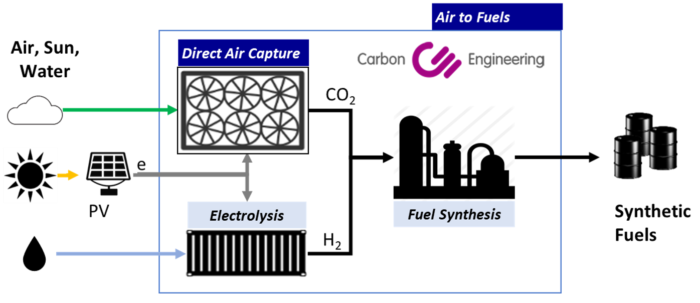Bill Gates is backing a plan for air to fuels technology

'Air to fuels' technology promises to clean up the atmosphere and provide clean fuel. Image: REUTERS/Felix Ordonez

Get involved with our crowdsourced digital platform to deliver impact at scale
Stay up to date:
Energy Transition
Could the future of clean energy be to turn air into petrol? It may sound too good to be true, but Microsoft co-founder Bill Gates and his partners are experimenting with air to fuels technology that could potentially help stop global warming as well as provide clean fuel. At their facility in Squamish, western Canada, engineers have already succeeded in extracting CO2 from the air and using it to produce a mix of petrol and diesel. They hope to eventually replicate the process on an industrial scale, the Guardian reports.
Carbon Engineering, a company set up by Gates, physicist David Keith and oil sands magnate Norman Murray Edwards, and its partner, Canadian energy company Greyrock, announced last December that they had made a vital breakthrough. Carbon Engineering had succeeded in using captured CO2 to synthesize a mix of petrol and diesel.
The air to fuels technology
The individual technologies, such as carbon capture and fuel synthesis, are not new. But combined, scaled up and powered by solar energy, they could clean up the planet while offering a new source of carbon-neutral fuel that uses less land and water than biofuels. Carbon Engineering estimates that once scaled up, the technology could produce fuels for less than $1 per litre.
Their process, known as “air to fuels” (or A2F) consists of three main steps. First, CO2 is captured from the air and purified. The facility in Squamish already removes one tonne of CO2 per day from the atmosphere, but previously, this was simply released back into the air as the rest of the process was not developed enough. Next, clean electricity, such as solar power, is used to split hydrogen from water. In the final step, the CO2 and hydrogen are synthesised into fuel, such as diesel and jet fuel. Fuels produced this way are also cleaner burning than fossil fuels, according to Carbon Engineering.
“A2F is a potentially game-changing technology,” it says on its website. It “offers an alternative to biofuels and a complement to electric vehicles in the effort to displace fossil fuels from transportation”. While electric vehicles are more suited to shorter distances, long-haul transport, ships and airplanes still need the high-energy density of liquid fuels, according to the company.
Do critics support technologies like ‘air to fuels’?
Critics argue that the world’s main priority should not be to capture CO2 but to emit less of it in the first place.
In the journal Science, Professor Kevin Anderson, deputy director of the Tyndall Centre for Climate Change Research, and Glen Peters, research director at the Centre for International Climate Research (Cicero) in Norway, argue that the technologies to remove carbon may not work at scale.
Anderson warns that governments are assuming that such air to fuels technologies will clean up the atmosphere in the future, according to the Guardian. This gives them less of an incentive to cut emissions now. Anderson points out that it is also a dangerously optimistic assumption given how new and unproven these technologies are on a large scale.
“They are not an insurance policy; they are a high-risk gamble with tomorrow’s generations, particularly those living in poor and climatically vulnerable communities, set to pay the price if our high-stakes bet fails to deliver as promised,” Anderson says. If the technologies are not as successful as promised, “our own children will be forced to endure the consequences of rapidly rising temperatures and a highly unstable climate.”
Bill Gates has argued that governments and companies need to invest in a wide range of cutting-edge energy technologies, from solar fuels to more efficient grids, even though it may take many years for them to work at scale.
“Breakthroughs in energy technologies could reduce air pollution, help people escape poverty, and avoid the worst effects of climate change,” he said in an opinion piece on clean energy last year. “But here’s the tricky part: we don’t yet know which ones will succeed. So we need to explore lots of ideas with investments from both the government and the private sector.”
Don't miss any update on this topic
Create a free account and access your personalized content collection with our latest publications and analyses.
License and Republishing
World Economic Forum articles may be republished in accordance with the Creative Commons Attribution-NonCommercial-NoDerivatives 4.0 International Public License, and in accordance with our Terms of Use.
The views expressed in this article are those of the author alone and not the World Economic Forum.
Related topics:
The Agenda Weekly
A weekly update of the most important issues driving the global agenda
You can unsubscribe at any time using the link in our emails. For more details, review our privacy policy.
More on Energy TransitionSee all
Katie Fedosenko and Luciana Gutmann
April 15, 2024
Johnny Wood
April 11, 2024
Alexandre Raffoul and Kai Keller
April 10, 2024
Roberto Bocca
April 10, 2024
Naoko Tochibayashi and Naoko Kutty
April 10, 2024
Linda Lacina
April 5, 2024







